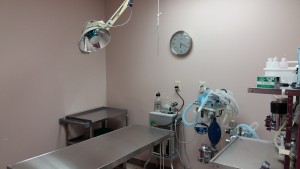Our doctors are available for both routine and non-routine surgeries. Prior to all surgical procedures, the patient will have a physical examination and blood work to assess for any concerns that need to be addressed prior to surgery or at the time of surgery. Presurgical blood testing allows the doctors to assess and ensure your pet’s internal organs are functioning appropriately and that they are a good anesthetic candidate before having general anesthesia performed. During the pre-surgical examination, you will be provided with a surgical plan so that you are aware of what procedures will be performed during your pet’s stay in the hospital.
Almost all surgical procedures that we provide require general anesthesia. This means that the patient will stay most of the day with us. A typical drop-off time is between 8-8:30 am, and all but a very select few patients are discharged on the same day as surgery.
Once in the hospital, most surgical patients will receive an intramuscular sedation injection to help with relaxation. This minimizes stress for catheter placement and allows for intravenous injections and endotracheal intubation for the delivery of gaseous anesthetic and oxygen. These medications reduce blood pressure and body temperature and cause respiratory depression. In an effort to combat the negative effects of the aforementioned conditions, all surgical patients are heated and given warmed intravenous fluids, and their heart and respiratory rhythm and rate are monitored closely during surgery so that anesthetic changes are implemented as necessary. During the post-operative period, all surgical patients continue to have intravenous fluid therapy and are monitored for pain medication requirements.

Avonlea Animal Hospital Surgery Room
Will My Pet Be Safe Under Anesthesia?
Modern anesthesia is very safe. Veterinarians anesthetize animals on a daily basis. At least once per week, in
any clinic, a pet owner expresses concern about anesthesia. The risk of a pet dying under anesthesia is less
than 1%. The rare patients that are lost under anesthesia are generally emergency surgeries when the
patient’s condition is extremely critical. The risk of a pet dying under anesthesia while undergoing a routine
spay, neuter, dental or mass removal is extremely low, but this risk can be affected by the anesthetic drugs
used and the monitoring of the patient.
Can you imagine an anesthesiologist in a human hospital using ether or chloroform in the 21st century? Of
course not!! But, unfortunately (and surprisingly), there are no standards of care for veterinary anesthesia,
and some clinics are still using out-of-date techniques. At Hollybank Animal Hospital we provide up-to-date
care to ensure the safety and comfort of your pet. Here is a list of support that we provide your pet to ensure
their safety and comfort:
- Pre-anesthetic blood: All patients, not just the old or sick, are recommended to have basic pre-anesthetic
blood tests performed to check blood sugar, kidney values, liver, immune system cells and red blood cell
count. Some animals may require more extensive pre-anesthetic blood work, such as thyroid or urine testing.
Even in animals under one-year-old, blood work will occasionally detect abnormalities that could affect
anesthesia. The pre-anesthetic blood work allows us to customize the anesthesia to your individual pet. - Intravenous fluids administered during anesthesia: Many drugs used for general anesthesia tend to cause
blood pressure to decrease. Intravenous fluids will combat this decrease. In addition, if there are any adverse
reactions under anesthesia, an intravenous catheter allows immediate administration of emergency drugs. - Your Pet’s body temperature is maintained during and after anesthesia:
All animals, especially cats and small dogs, lose a lot of body heat under anesthesia. The resulting
hypothermia can slow the anesthetic recovery. By providing active warming, we minimize the time your pet
spends in recovery. - Your pet will be intubated, and maintained on anesthetic gas:
Intubation means that the patient has an endotracheal tube placed through the mouth and into the trachea,
through which gas anesthetic is administered. The endotracheal tube allows controlled respirations if the
patient is not breathing well on his or her own, and prevents accidental inhalation of stomach contents if the
pet vomits under anesthesia. Virtually every surgical procedure done in dogs and cats requires intubation and
gas anesthesia. - Pain Control: Even in the gentlest of hands, surgery is painful! Analgesia is the relief of pain, and
in modern anesthetic protocols, we strive for pre-emptive analgesia (blocking the pain pathways
before the painful procedure starts), and balanced analgesia (trying to block the pain pathways from
as many directions as possible).
Your pet will be provided with pain medications before any procedures occur to minimize any pain
your pet may feel. For cats, we often use a long-lasting pain medication, administered once
immediately after surgery. This eliminates the need for you to touch or handle their mouths, which
are often sore after dental surgery. For dogs, there are a variety of pain medications available, and
we tailor this individually depending on the patient’s requirements and underlying health concerns. - Monitoring techniques: It is critical to monitor the patient’s vitals while under anesthesia to
ensure that the respiratory and cardiovascular systems are functioning well, and to ensure that the
patient is not under too lightly or too deeply. A registered Veterinary Technician is beside the
surgeon (who is occupied), monitoring the heart rate, respiratory rate, and anesthetic depth. In
addition to hands-on monitoring, your pet’s respiratory rate and in some cases, blood pressure, are
monitored by machines.
Why is it so expensive?
As you can see, modern anesthesia involves a lot of equipment and expertise, and this unfortunately costs
money. Cutting corners by not intubating patients, not keeping patients warm, or not providing pain
medications and monitoring can save money, but the price is decreased comfort and safety for your
pet. By providing all possible safety measures and addressing these issues, we ensure that your pet
will be as safe and comfortable as possible before, during, and after their procedure!
Elective surgery refers to preventative surgery performed on a healthy patient. Surgeries would include neuter (castration), spay (ovariohysterectomy), umbilical hernia repair, declaw, tail dock and dewclaw removal.
All of our veterinarians are very experienced at performing soft tissue surgery including removal of skin lumps, and several different procedures involving the intestines and stomach. More complex soft tissue surgeries are also performed by specific doctors on request. This would include splenic, urethral and liver surgery.
Dr. Rosely is specially trained and certified to perform several orthopedic surgeries including anterior cruciate ligament stabilization, patella luxation surgery, femoral head and neck excision arthroplasty and amputation.
Several of our doctors are available to perform surgery of the eye and the structures around the eye. Surgeries include cherry eye fixation, entropian and ectropian correction, keratectomy of the cornea, and enucleation of the eye.
All of our doctors are available to perform surgery of the urinary bladder (bladder stone removal), penis and vulva. Dr. Rosely is specially trained and certified to perform perineal urethrostomy surgery which is a lifesaving surgery performed on urinary obstructed patients.
